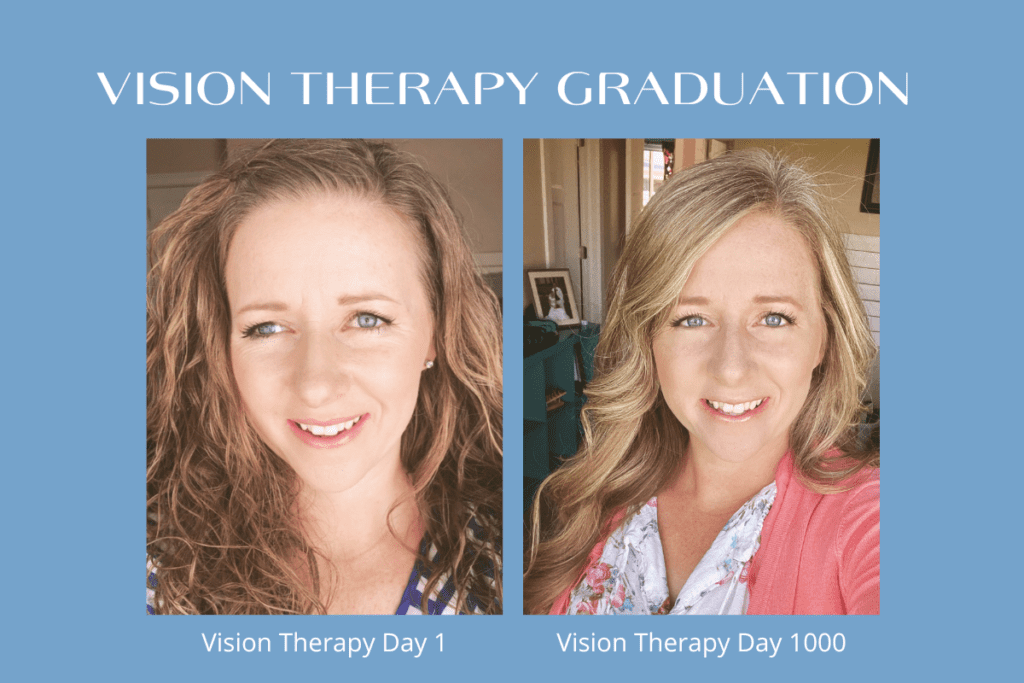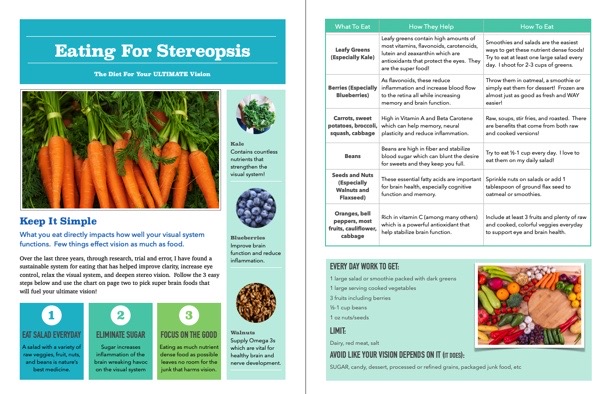Night driving became a huge struggle for me around age 31 when my strabismus and lazy eye became more of a problem. I am happy to say that over the last 3 years my night time driving has improved tremendously. Even when I’m suppressing and only using one eye, it is still so much better because I have learned to follow some basic principles that make a big difference.
So what can you do to improve your night driving if you have strabismus? Take good care of basic eye health by blinking often, breathing deep, correcting vision and eating healthy. With your eyes in optimal health you can add eye exercises to build peripheral and night vision like looking for parallax and finding the lights. Put your car in optimal condition and consider adding anti-glare to your glasses and you will be on your way to confident night driving!
Keep reading for details on why night driving is more difficult for those of us with strabismus and specific ways to improve night driving with peripheral exercises that you aren’t going to find anywhere else.
To become an expert of peripheral vision and to take your depth perception to the next level, be sure to check out Mastering Peripheral, the course I created for people exactly like you. You will be able to confidently use your vision to its full extent.
Why is Driving at Night So Difficult?
There are many factors that make driving at night more difficult for everyone, not just those of use with strabismus.
- Low light
- Glare from oncoming lights
- Lack of monocular depth cues like shadows, relative height, texture gradient, relative size, etc.


If you have strabismus, you can add to the list
- Double Vision
- Lack of Stereopsis
- Light Sensitivity
- Lack of Peripheral Vision
With strabismus, you can count on a lack of stereopsis or good 3D vision which drastically decreases our depth perception. We are only using one eye at a time to see anything. In order to judge depth, day or night, our brain can’t do magical mathematical calculations using the images from each eye to see how far away something is, we need to use monocular (one eyed) depth cues.
Monocular cues only need one eye so they are super helpful if you can only see out of one eye at a time. Information from shadows, size differences, motion parallax, overlap of near objects over far ones and texture are how we get around the world without running into walls or rear ending cars (for the most part).
At night, these monocular cues are significantly diminished because of the low light. We naturally have no binocular depth cues so when our monocular cues are all but destroyed, the depth perception becomes a major problem.
The bright lights we see at night also produce glare which is distracting and irritating and can reduce reaction time. This is one of the main complaints most people face with night driving.
Another problem unique for strabismics at night is double vision. For some, they are able to keep single vision throughout the day with significant effort, but by the end of the day (when it happens to be dark) it is more difficult and double vision is more likely. Add the stress of night driving and bright lights and it can be a recipe for disaster by double vision.
What are You Doing to Sabotage Your Night Driving?
Before I give you what to do, I want to share a few things you are probably currently doing to sabotage your night driving and make it even more difficult than it needs to be.
Staring at oncoming headlights– Your eyes are attracted to light and you might find yourself looking at oncoming lights. This will produce significant glare, make you feel blind when you look back towards the dark it will seem even darker.
Squinting– Squinting puts added stress on your visual system and forces you to see small. This decreases your peripheral view, strains your vision and is physically exhausting.

Holding Your Breath– Holding your breath is an automatic response when you’re nervous, which is likely when you are uncomfortable with driving at night. The problems is that it can decrease blood flow to your brain which can lead to more blurry vision.
Staring at the line on the side of the road-While this is a very popular solution to bright oncoming headlights, restricting your vision in this way diminishes your peripheral vision and sense of space drastically.
Looking Small-When everything looks scary, there is a natural tendency to try to close off your vision. Just stare at the car in front of you and try to ignore the world until you get home…sound familiar. Again, this is going to destroy the one tool that makes the biggest difference at night, your peripheral vision.
Thinking “I can’t drive at night!”-I can’t help but go into the mindset part of the puzzle. If you are thinking, “This is so hard, I can’t do this,” you can bet that you will be staring without blinking, holding your breath, gripping the steering wheel and closing off your peripheral vision.
What Can I do to Improve Night Driving Starting Today?
Now that you can see what you are doing to sabotage your night driving, let’s take a look at some behaviors to replace those habits with so that you can feel comfortable and confident driving at night starting today.
Eye Health Basics
Blink– Dry eyes can actually make the glare from bright lights at night worse. Some opt to use artificial tears, but a simple option is to blink often. Blinking can keep your eyes moist, relaxed and prevent staring.
Breath– Breathing properly can change your life (Proof by Book: Breath by James Nestor) Increase the blood flow to your eyes and brain, decrease strain and stress, open your peripheral and more by taking simple deep breaths.
Eat Healthy– Sugar can significantly increases inflammation in your entire body. When this spreads to your eyes and brain you can count on more sensitivity to light, and blurry vision. If you want the free guide on eating for good vision, download it HERE. The basic idea is to eat nutrient dense foods like fruits and veggies and slow down on inflammatory foods like sugar. This makes a huge difference, trust me (and believe me, no one is more annoyed that cutting out sugar helps than me…I love sweets).
Wear Your Glasses– I feel like this goes without saying, but make sure to wear glasses that correct your visual acuity and if you have trouble with double vision, glasses with prism can help significantly.
Anti-Glare- Ask your optometrist to use an anti-glare coating on your glasses. This will lessen the distracting and disorienting glare from the headlights of other cars.
Car Basics
Clean Window– Take the time to clean the outside and inside of your car windows.
Clean Headlights– Having plenty of light makes judging distances easier, ask your favorite mechanic make sure your headlights are clean and fog free.
Exercises
Improving your peripheral vision is KEY to driving better at night. You can see so much more than you think, but you need to be looking for it. For more in-depth explanations, exercises, challenges and more, purchase “Mastering Peripheral.”
Find The Light- Instead of staring at or completely avoiding oncoming headlights, expand your vision. Your central vision may be pointed forward, but use your peripheral to find every light you can. Can you see the headlights from multiple cars, stars in the sky, street lights, Christmas lights, etc. As you expand your peripheral to find all of the lights, you will realize how much you can see, not what you can’t see. You will also have a comprehensive view of where you are in space, which will help you navigate more effectively.

Find The Lines– When you are being attacked by someone’s oncoming brights, replace staring at the line on the side of the road with gazing softly at the line with your central and using your peripheral to discover how far the line goes. Start small, can you see the line the whole way from your vehicle to the next? Then expand, can you see the line disappearing over the next hill? Can you also see the middle line in your peripheral? This strategy is going to again give you a comprehensive view of where you are driving.

Find Motion Parallax– Another favorite way to expand the peripheral view and make driving at night easier involves motion parallax. As you drive forwards, watch for the opposite motion of the world moving past you. As you look for this movement, your peripheral will expand significantly.
Mind Games
If you’ve been following this blog for a while, you’ll know that I believe whole heartedly that our thoughts make a bigger difference than most things when it comes to strabismus. Change your thoughts and you will make more progress than with anything else.
| Relace This: | With This: |
| I can’t drive or see at night, my vision is broken | I am descended from the mighty hunter-gatherer, I was made for this! |
| I have no depth perception and it is not safe for me to be out here! | I am an expert of monocular cues, stereopsis isn’t the only tool for depth. |
| This is so scary. | It’s okay to be scared |
| I will never be able to be independent if I can’t drive at night. | This is figure-out-able |
These skills are all going to take practice, and practicing is much better done when you are the passenger, not the driver. Even though I still don’t have perfect stereo vision and sometimes even suppress or get double vision, especially at night, I can use these skills to make night driving safe and comfortable.
Your brain can judge depth, maybe not in the same way as the rest of the world, but take what you have and run with it, expand it, practice it and you can still have so much success.
What Can I do to Improve Night Driving Long Term
Each of these tips and tricks is going to be helpful and you can use monocular cues to improve depth perception and night driving, but it would be dishonest if I didn’t say that having stereopsis is going to make it 10 times easier.
Stereopsis or stereo vision is the ability to judge how far away objects are, using and combining the images seen out of each eye. This also gives objects a more three dimensional shape to the world and allows us to see space between objects.
This is why adults with strabismus, across the board, have a higher incidence of difficulty driving at night. We are lacking one major skill that makes judging distances and seeing in the dark much easier.
So the questions is, “Is it possible to gain stereopsis if I have strabismus?“
The answer is yes, and no, and yes, and kind of.
Stereopsis isn’t a light switch that is either off or on, it is a continuum. If someone is blind in one eye, they may be on one end of the spectrum while someone with perfect vision is on the other. Every person is going to be somewhere on that continuum based on so many factors; screen time usage, strabismus, cataracts, age, etc.
Can you improve your stereopsis? Absolutely.
Can you have perfect stereopsis? Probably not.
How Can I Improve Stereopsis?
We could spend hours discussing this, but you need two basic components to have stereopsis.
- Eyes that are relatively straight (perfectly straight for perfect stereopsis)
- A brain that can use both eyes together
Vision Therapy is a fantastic way (and the only way that really works long term) to teach the brain to use both eyes together. It is done with a developmental optometrist (find one HERE) and involves eye exercises, vestibular rehab, lenses, prism, and so much more. Learn more about vision therapy HERE.

Surgery can help align the eyes which can significantly improve peripheral vision and restore single vision if it was present before (rare). It doesn’t teach the brain to use both eyes and needs to be combined with therapy to get stereopsis. Learn all about surgery HERE.
Closing Thoughts
Doing the work to improve the ability of your brain to use both eyes together is going to make a bigger difference than anything when it comes to improving night vision.
But that option isn’t available to everyone. I’m not going to lie, it can be expensive, time consuming and frustrating, but I will also tell you that it is worth every penny. Learning to use my eyes together has completely changed my life, and it can change yours too.
If pursuing vision therapy isn’t an option for you right now, then use the tips in this article. They can get you half-way there and improve your night driving significantly.
Be sure to schedule a consultation with me if you would like to learn more about whether vision therapy, surgery or neither could be a good option for you.

